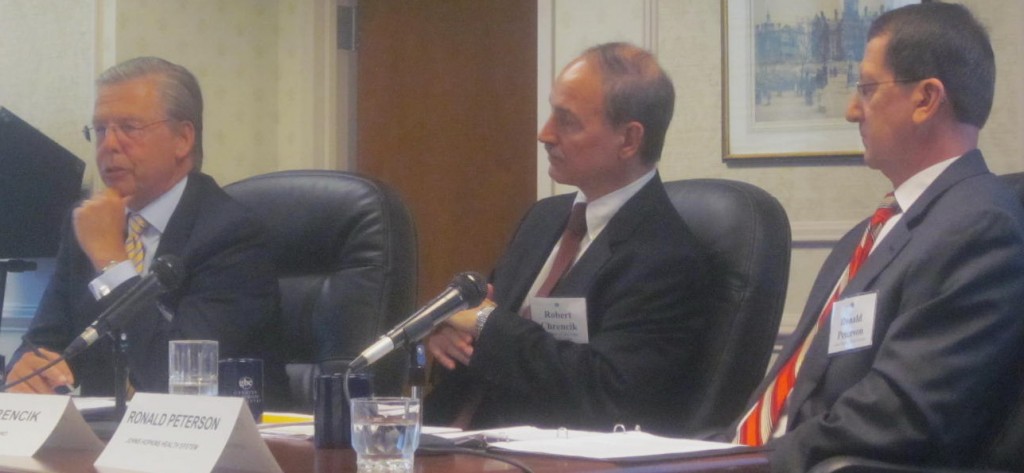Affordable Care Act full of consequences and potential surprises
By Len Lazarick
[email protected]

Health care CEOs, from left: Chester Burrell, CareFirst; Robert Chrencik, University of Maryland Medical System; and Ronald Peterson, Johns Hopkins Health System.
The Affordable Care Act upheld by the Supreme Court in late June is unbelievably complicated, results in new tax burdens, require lots of new paperwork, makes the shortage of primary care physicians worse and will likely produce some surprises as unexpected consequences unfold.
But it will expand health insurance coverage and possibly bend down the curve on costs by giving better access to care and changing payment methods.
That’s what a trio of CEOs of the Baltimore region’s top health care providers and insurers told a breakfast at the Greater Baltimore Committee Monday.
There was nothing terribly new in the presentations by the heads of CareFirst BlueCross/Blue Shield, the University of Maryland Medical System and the Johns Hopkins Health System. But the court’s affirmation of the health care overhaul meant there would be no reprieve from the changes – unless much of the law is repealed by a new Congress and administration, which the executives considered unlikely.
But the new requirements and spending will likely collide with attempts to reduce the federal deficit, and clamp down on Medicare and Medicaid.
If not repeal, starvation for new law
“If you don’t want to change the law, you can starve the act” by cutting federal spending, said Robert Chrencik, president and CEO of the University of Maryland Medical System. And regardless of any modifications to the Affordable Care Act, the government programs will force providers not just to provide care but to manage care by keeping patients out of high-cost settings.
“I don’t think there’s any coherent plan B” if the Affordable Care Act would somehow be repealed, said Chester Burrell, CareFirst president and CEO. (Republicans in the U.S. House are scheduled to take such a vote Wednesday.)
Chrencik made clear that businesses needed to prepare to implement the new law, which should provide a lot of work for lawyers and accountants.
“There needs to be someone in your organization who has a good grip on this law,” Chrencik said. There will also likely be pages added to individual tax returns to account for whether health insurance has been bought, as now mandated.
One audience member suggested thousands of new IRS agents would be needed to police the new health regime. Burrell said, “The costs to the private sector exceed the costs in the public sector.”
Maryland officials had already embraced the new law whole hog, and Burrell noted that “this state already has more than a decade behind the ideas in the Affordable Care Act.”
Maryland is further along than most other states in implementing the health care benefits exchange, which will allow employers and individuals to shop for health insurance.
A defined contribution approach
Burrell expected that many employers will take the approach that has happened in the shift in pensions from defined benefits to defined contributions. Employers will tell their employees how much they’ll contribute to health insurance, then tell them “You go on the exchange and pick what you want.”
“We think there will be the advent of private exchanges,” rather than just the government-run health insurance exchange set up by Maryland this year, Burrell said.
The providers support the effort to expand coverage to the uninsured since “they tend to access health care at a pretty late stage in the process” of getting ill, said Ronald Peterson, president of the Johns Hopkins Health System. Currently, about 14% of Marylanders are not covered by insurance.
Shortage of primary care
But he was concerned that the new law “has not addressed health care workforce development.”
“We will have to expand the ranks of health care workers,” Peterson said. There is already a shortage of primary care and family physicians and there needs to be “new methods of health care delivery that will be more effective.”
“I think that is a huge disconnect in this,” said Chrencik. The law will drive more people to seek basic and preventative care, but the costs of medical education are driving young doctors into specialization where the income is higher.
“It’s a no brainer” when doctors are choosing what field to pursue, Chrencik said. “They’re struggling; they’ve got a lot of debt.”
No rewards for caring for chronically ill
Burrell said there is a “demographic tsunami” of chronic disease, but there are no rewards for taking care of the chronically ill from conditions like diabetes and heart disease.
CareFirst Blue Cross/Blue Shield covers about 3.4 million people, but 3% of the people consume 37% of the dollars, and the next 7% of the chronically ill consume 32% of the health insurance costs. The bottom half only consumes 6% of the resources.
“You can’t just insure sick people,” Burrell said. That’s the basic reason behind the mandate for everyone to buy insurance.
He emphasized that there are still many unknowns in implementing the lengthy and complicated new law. “There could be a lot of dislocation,” Burrell said. “There could be surprises. All the regulations are not out yet.”

MarylandReporter.com is a daily news website produced by journalists committed to making state government as open, transparent, accountable and responsive as possible – in deed, not just in promise. We believe the people who pay for this government are entitled to have their money spent in an efficient and effective way, and that they are entitled to keep as much of their hard-earned dollars as they possibly can.
